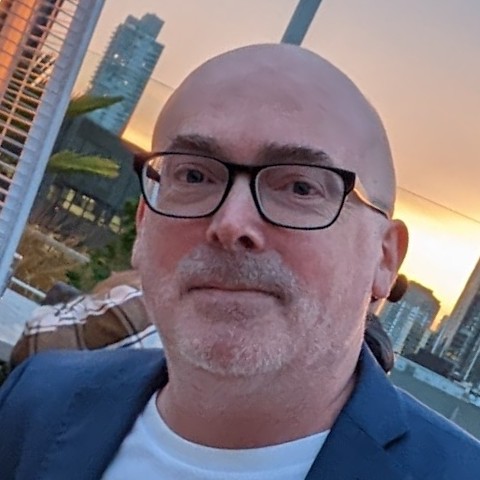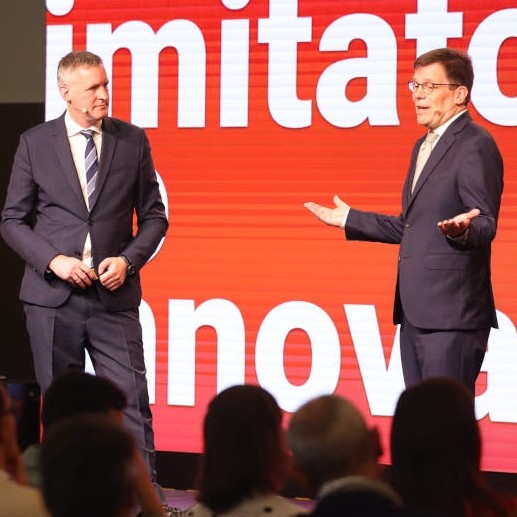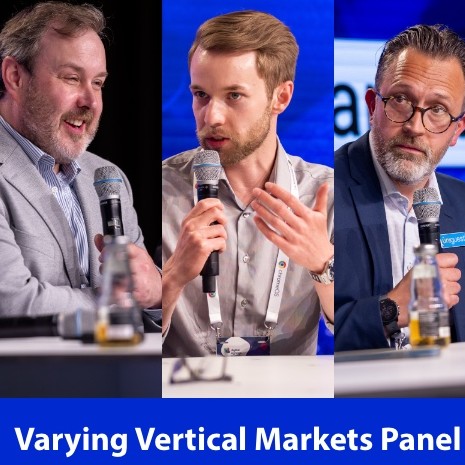Chris Cavalieri, Obsidian Screens
Description
The 16:9 PODCAST IS SPONSORED BY SCREENFEED – DIGITAL SIGNAGE CONTENT
Projection has always been something of a fringe player in digital signage because of a series of technical barriers to adoption, most notably the limited operating life of the lamps, and the product and labor costs of switch them out. Laser projection has addressed that issue, but the other one that's harder to conquer is dealing with ambient light. Unless the projector is the size of a fridge, super-bright and seriously expensive, the environment's lights need to be off or dimmed and any windows covered.
A startup called Obsidian Screens, based on the fringes of greater Toronto, has developed a projection screen that can show visuals that aren't washed out even with the lights on and the blinds open - and as the brand name suggests, the screens are black instead of white or silver. It's a super-thin laminated material light enough to marry with foam - like a poster with a 1/4-inch foam backing to make it rigid and ready to hang.
Co-founder Chris Cavalieri and his business partner use Ambient Light Rejecting technology - something that's been around for years - but have their own "nanofilter" technology that does a better job, he says, of preserving projector brightness and visibility. And just as is the case with LED video walls, the more black on the display surface, the better the contrast.
The company has been around for seven years, but remains quite small ... as they have struggled to find the right partners to specify, sells and deploy their tech. They've run into at least a couple of challenges - with end-users who were disappointed by conventional projection set-ups, and pro AV integrators who for logical reasons want to sell systems that cost a lot more and need ongoing paid support and services.
Subscribe from wherever you pick up new podcasts.
TRANSCRIPT
Chris, thanks for joining me. You're based outside of the Greater Toronto Area and you've been working for a few years now on a company called, well, a product called Obsidian. Can you run through all of that for me?
Chris Cavalieri: Sure thing. Thanks for having me, Dave. I really appreciate taking the time to talk about it and boy, do I have lots to say.
You have half an hour. Go!
Chris Cavalieri: All right. Perfect. No pressure. So Obsidian, I should probably talk a little bit about projection. So what we've been trying to do and we've been doing for a while, is trying to find a way to take all the benefits. So if anyone's in digital signage, I assume there's a few listening to this what incredible things can be done with projection. So things like projection mapping holographic displays, very unique, creative stuff, and it's absolutely fantastic, and when we started out, we looked at things and said, like, why isn't this used more?
You know, we go to retail stores, we're going to shopping centers and there are LEDs, we've got LCD video walls now and only a few set cases, maybe a performance or display are using projection to its full potential and it begs the question is why, and that why is how we found it, our idea of Obsidian, which is to create a solution to get those benefits projection and make it a lot more accessible and practical in place of, or as an option compared to say our elite typical LED signage and LCD video walls.
So, I mean, projection, it's very renovation friendly, it's very scalable, and depending on what projector you use, it can be quite a low cost, the benefits are endless, and compared to LEDs, which are quite glaring, most of the time, I'm biased, obviously, no shame in that, but most people don't want to stare at an LED board as a backing, screen for like a speaker stage, for example, casino games. We've talked to fellows in Vegas before. It causes fatigue for people who are near them for too long. And that's, that comes down to the human eye and there's a whole science behind it, the wavelength of lights and all that. I won't go into it. It works. It's bright. It gets people's attention, but it just doesn't give the same aesthetic as a good projection setup would.
So coming back to it, why don't we use projection? And quite frankly, it's because it mostly just sucks because it fails. You need to have a dark room, dim room, or very well-controlled lighting, and by having controlled lighting and those restrictions, designers or retail commercial designers can't do solutions they want to do where this challenge is like a window nearby and sunlight there are challenges that they can't overcome and maintain a good looking display and that's where LEDs kind of help punch through that.
So the question is what if we had a solution where projection can punch through that can give you those same benefits and versatility, but you can have nearby lights? You don't have to overly control your space. I mean, of course, you can't do shopping in a grocery store with your lights off or a shopping mall. You know, it's not practical. You might be able to do a half-hour show or presentation, but it doesn't make sense, and that's at least my conclusion personally, my experience is why we don't see more of these really cool-looking projection map displays than we do now. It doesn't work in most cases. When it does, it's great, but most of the time it doesn't.
So Obsidian is basically to solve that problem. we've got our own proprietary technology and IP around it, and we've designed a system that harmonizes the projector and the screen, and we include the lighting as well for nearby lighting to essentially use the nanofiller technology to work together and what I mean in a very blunt sense from that is that these systems will work independent of the environment around it. So if people have heard of light rejecting screens, ALR screens essentially you have a gray screen or a silver screen. It'll absorb about 50%-60% percent of your light in the room and that gives you contrast, which is great because it helps you have a more adaptable, flexible display.
What our system does is the same thing, but that absorption, instead of normally it'll absorb your projector. So your white becomes gray, silver, whatever it is. In our case, your projector can shine on the screen and your lights can shine near or on the screen and have no loss, so it will reflect off of it. It keeps its colors, it keeps its white balance, and then the ambient light that is basically using this filter will absorb completely, not just the 60%. Whereas everything else gets knocked down by 50%-60%, and it creates this really neat illusion and really efficient display where fundamentally it's the same as any projection system, but you can see all your colors just popping. You maintain your contrast and your white balance and it's almost like you've doubled the lumens in your projector, and we love this because this opened up an option for again, adding an accessible and affordable solution somewhere between a TV set, and an LED video wall, where again, you can have something that's highly visible. It's got wide viewing angles. It keeps its color resilient, but you can also be adaptive. So again seasonal renovations for a retail environment stores, places where you don't really want to control lighting or it's too much work to deal with it. Plus you can install the thing in under a day. I mean, we've hung screens in under an hour compared to perhaps weeks on a video wall. So maintenance costs and benefits are endless.
So that was our goal with Obsidian again. What is holding it back from creating unique creative solutions? And how do we overcome that in this nanofilter system? And I think most people are afraid of it because it wasn't easy to develop and there are restrictions to it. Again, it's got to work as a cohesive system, that scared people and got a lot of resistance, but boy, does it work.
You're an engineer. I'm absolutely not. For simpletons like me, the simpleton explanation would be that instead of this being a white or silver screen, it's a black screen, correct?
Chris Cavalieri: It is a black screen. So if you turn your projectors off and look at it, it'll look kind of a charcoal gray, maybe a little bit of a greenish tint to it, and you know, that's kind of like a decorative wall panel, and that's what it looks like. That's what it is, and that's because the light is bouncing off, it's still being absorbed. Their eyes don't have the nano filters in them. If you wear polarized sunglasses, you might, it might be interesting but that's essentially what's going on there. So it is indeed a dark-colored screen.
When you describe it as a system, you're talking about the kit of parts, but your part is the screen. The challenge with projection and the reason. It wasn't it hasn't really grown very much in digital science or anywhere else used to be with the projector and the lamp life and how you'd have to replace it all the time and it was unreliable and also that it wasn't very bright. Lasers have changed that. other technologies have improved. So that side is somewhat conquered. However, if you want a very bright projector, you're getting something the size of an Austin Mini. But, the screen thing is still by and large a white screen, right?
Or film that you apply to a window glass that will make an image appear, but it's not very sharp or bright, I mean.
Chris Cavalieri: Exactly. I mean, that's the only solution people had to date is to get a bigger projector, and what's really unique about using our nano filter technology is you don't need a brighter projector to achieve the same result as you would. So there's almost a savings. I
























